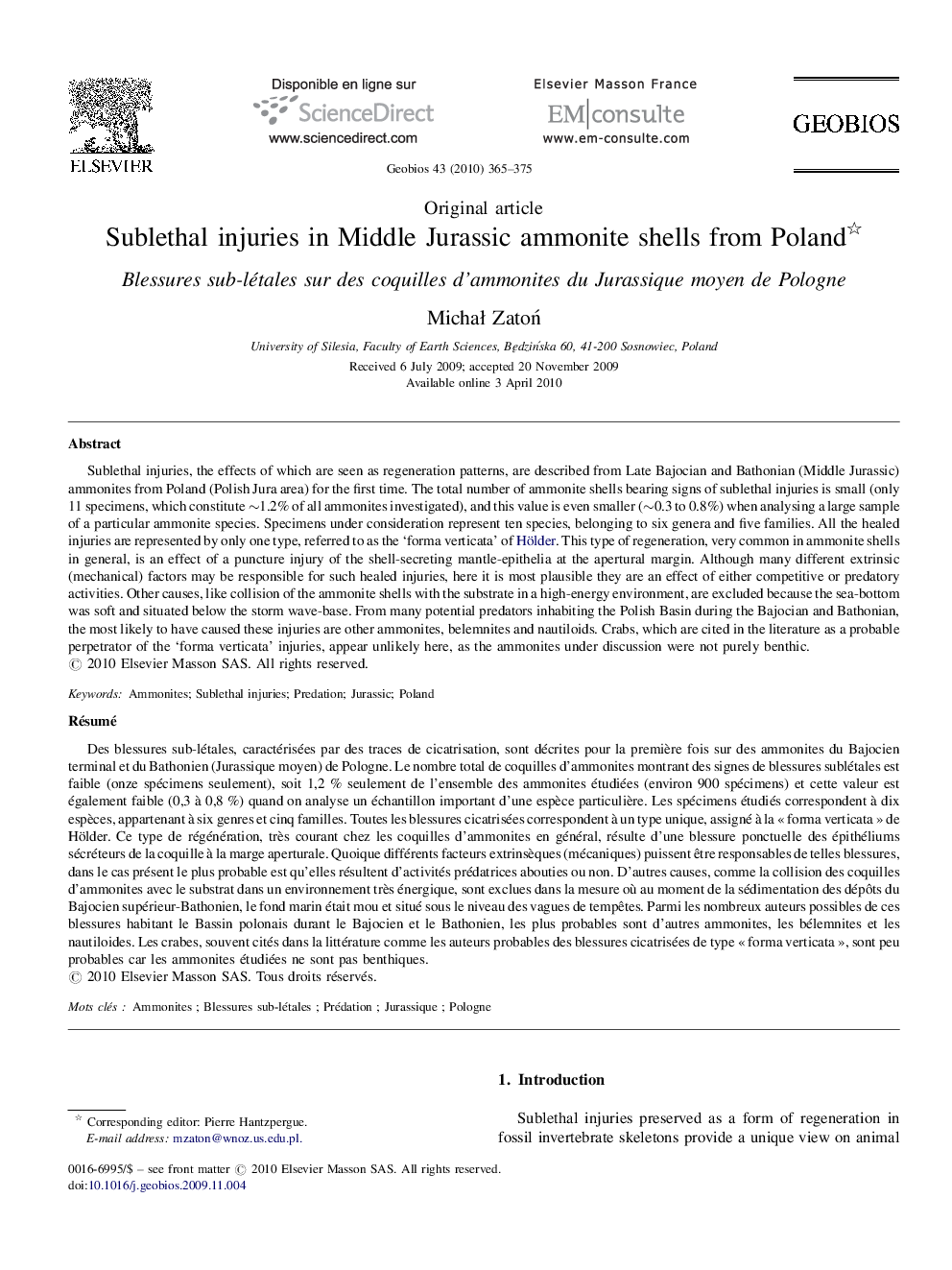| Article ID | Journal | Published Year | Pages | File Type |
|---|---|---|---|---|
| 4748357 | Geobios | 2010 | 11 Pages |
Sublethal injuries, the effects of which are seen as regeneration patterns, are described from Late Bajocian and Bathonian (Middle Jurassic) ammonites from Poland (Polish Jura area) for the first time. The total number of ammonite shells bearing signs of sublethal injuries is small (only 11 specimens, which constitute ∼1.2% of all ammonites investigated), and this value is even smaller (∼0.3 to 0.8%) when analysing a large sample of a particular ammonite species. Specimens under consideration represent ten species, belonging to six genera and five families. All the healed injuries are represented by only one type, referred to as the ‘forma verticata’ of Hölder. This type of regeneration, very common in ammonite shells in general, is an effect of a puncture injury of the shell-secreting mantle-epithelia at the apertural margin. Although many different extrinsic (mechanical) factors may be responsible for such healed injuries, here it is most plausible they are an effect of either competitive or predatory activities. Other causes, like collision of the ammonite shells with the substrate in a high-energy environment, are excluded because the sea-bottom was soft and situated below the storm wave-base. From many potential predators inhabiting the Polish Basin during the Bajocian and Bathonian, the most likely to have caused these injuries are other ammonites, belemnites and nautiloids. Crabs, which are cited in the literature as a probable perpetrator of the ‘forma verticata’ injuries, appear unlikely here, as the ammonites under discussion were not purely benthic.
RésuméDes blessures sub-létales, caractérisées par des traces de cicatrisation, sont décrites pour la première fois sur des ammonites du Bajocien terminal et du Bathonien (Jurassique moyen) de Pologne. Le nombre total de coquilles d’ammonites montrant des signes de blessures sublétales est faible (onze spécimens seulement), soit 1,2 % seulement de l’ensemble des ammonites étudiées (environ 900 spécimens) et cette valeur est également faible (0,3 à 0,8 %) quand on analyse un échantillon important d’une espèce particulière. Les spécimens étudiés correspondent à dix espèces, appartenant à six genres et cinq familles. Toutes les blessures cicatrisées correspondent à un type unique, assigné à la « forma verticata » de Hölder. Ce type de régénération, très courant chez les coquilles d’ammonites en général, résulte d’une blessure ponctuelle des épithéliums sécréteurs de la coquille à la marge aperturale. Quoique différents facteurs extrinsèques (mécaniques) puissent être responsables de telles blessures, dans le cas présent le plus probable est qu’elles résultent d’activités prédatrices abouties ou non. D’autres causes, comme la collision des coquilles d’ammonites avec le substrat dans un environnement très énergique, sont exclues dans la mesure où au moment de la sédimentation des dépôts du Bajocien supérieur-Bathonien, le fond marin était mou et situé sous le niveau des vagues de tempêtes. Parmi les nombreux auteurs possibles de ces blessures habitant le Bassin polonais durant le Bajocien et le Bathonien, les plus probables sont d’autres ammonites, les bélemnites et les nautiloides. Les crabes, souvent cités dans la littérature comme les auteurs probables des blessures cicatrisées de type « forma verticata », sont peu probables car les ammonites étudiées ne sont pas benthiques.
